| 021
|
CHAPTER 4
Examining and Evaluating the Disabled Child
To decide what kind of special help, if any, a
disabled child may need, first we need to learn as much as we can
about the child. Although we may be concerned about her
difficulties, we must always try to look at the whole
child. Remember that:
| A child's abilities
are more important than her disabilities.
|
The aim of rehabilitation is to help
the child to function better at home and
in the community. So when you examine a child, try to
relate all your observations to what the child can do, cannot do,
and might be able to do.
What a child is and does depends partly on other persons. So we
must also look at the child's abilities and difficulties in
relation to her home, her family, and her village or neighborhood. |
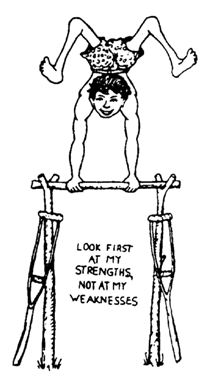 |
To evaluate a child's needs, try to answer these questions:
 | What can the child do and not do? How does this
compare with other children the same age in your community? |
 | What problems does the child have? How and when
did they begin? Are they getting better, worse, or are they the
same? |
 | In what ways are the child's body, mind, senses,
or behavior affected? How does each
specific problem affect what she does? |
 | What secondary problems are developing?
(Problems that result after and because of the original problem.) |
 | What is the home situation like? What are the
resources and limitations within the family and community
that may increase or hold back the child's possibilities? |
 | In what way has the child adjusted to her disability,
or learned to manage? |
To find the answers to these questions, a health or rehabilitation
worker needs to do 3 things:
- Observe the child carefully-including her
interaction with the family and with other persons.
- Take a 'history'. Ask the parents and child (if
old enough) for all information they can provide. Obtain medical
records if possible.
- Examine the child to find out how well and in
what way different parts of her body and mind work, how developed
they are, and how much they affect her strengths, weaknesses or
problems.
| BE SURE TO LOOK AT THE WHOLE CHILD-NOT JUST THE
DISABILITY |
|

| 022 |
| Observation of the child can begin from the first
moment the health worker or rehabilitation worker sees the child and
her family. It can begin in the waiting area of a village center, the
home, or the street, and should continue through the history-taking,
examination, and follow-up visits. Therefore, we do not discuss
'observation' separately, but include it with these other areas. It
is usually best to ask questions BEFORE beginning to examine
the child-so that we have a better idea what to look for.
Therefore, we will discuss history-taking and then examination. But
first a word about keeping records.
RECORD KEEPING
For a village rehabilitation worker who helps many children,
writing notes or records can be important for following their
progress. Also, parents of a disabled child may find that keeping
simple records gives them a better sense of how their child is doing.
Six sample RECORD SHEETS are on Pages
37 to 41, 50,
292, and
293.
You can use these as a guide for getting and recording basic
information. But you will want to follow with more detailed
questions and examination, depending on what you find. |
Sample RECORD SHEETS
included in this book |
RECORD SHEET
number |
Page |
| Child history |
1 |
37
and 38 |
| Physical examination |
2 |
39
|
| Tests of nervous system |
3 |
40
|
| Factors affecting child development |
4 |
41
|
| Evaluation of progress |
5 |
50 |
| Child development chart |
6 |
292 and
293 |
|
Sheets 1 and 2 will be useful for most disabled children. Sheets
3, 4, and 6 are for children who may have brain damage or seem slow
for their age. Sheet 5 is a simple form for evaluating the progress
of children 5 years old or older.
HISTORY TAKING
On Pages 37 and 38 you will
find a record sheet for taking a child's history. You can use it as
a guide for the kinds of questions it is important to ask. (Of
course, some of the questions will apply more to some children than
others, so ask only where the information might be helpful.)
When asking questions, we rehabilitation workers must always
remember that parents and family are the only real 'experts'
on their child. They know what she can and cannot do, what
she likes and does not like, in what ways she manages well, and
where she has difficulties.
However, sometimes part of the parents' knowledge is hidden. They
may not have put all the pieces of knowledge together to form a
clear picture of the child's needs and possibilities. The
suggestions in this chapter, and the questions on the RECORD SHEETS,
may help both rehabilitation workers and parents to form a clearer
picture of their child's needs and possibilities.
| Rehabilitation workers and parents can work
together to figure out the child's needs. |
|
| 023
|
EXAMINING THE DISABLED CHILD
After finding out what we can by asking questions, our next step
is to examine the child. In as friendly a way as possible, we
carefully observe or test what parts of the child work well, what
parts work poorly, and how this affects the child's ability to do
things and respond to the world around him.
| CAUTION: Although we sometimes
examine separately different aspects of the child's body and
mind, our main purpose is to find out how well the
child's body and mind work together as a whole: what can the
child do and not do, and why? This information helps
us decide how to help the child to do things better. |
In addition, a complete physical
examination would include checking the health of systems
inside the body. Although this part of the examination, if
needed, is usually done by health workers, rehabilitation workers
need to know that with certain disabilities inner body systems may
also be affected. Depending on the disability, these may include:
| Rehabilitation workers need to work in close
cooperation with health workers. |
A detailed examination of all a child's
parts and functions could take hours or days. Fortunately, in most
children this is not necessary. Instead, start by observing
the child in a general way. Based on the questions you have
already asked and your general observations, try to find
anything that seems unusual or not quite right. Then
examine in detail any body parts or functions that might
relate to the disability. |
| 024
|
 Part
of the art of examining a child is KNOWING WHEN TO STOP. Part
of the art of examining a child is KNOWING WHEN TO STOP.
It is important to check everything that might help us understand
the child's needs. But it is equally important to win the child's
confidence and friendship. Too much examining and testing can push
any child to the point of fear and anger. Some children reach their
limit long before others. So we must learn how much each child can
take - and try to examine the child in ways that she accepts.
Some children require a much more complete examination than
others. For example:
 Juan
lost one hand in an accident 2 years ago, but otherwise seems
normal. Probably he will need little or no physical examination
other than to see how he uses his arms, stump, and hand. Juan
lost one hand in an accident 2 years ago, but otherwise seems
normal. Probably he will need little or no physical examination
other than to see how he uses his arms, stump, and hand.
You will also want to check how much he can do with his other
hand, with only his stump, and when using both together.
The Physical Examination Form (RECORD SHEET 2 on
Page 39) is probably the only examination
form you need to fill out.
However, it would be wise to learn about how
Juan's family and others treat him now, and how he feels about
himself and his ability to do things. Does he keep his stump
hidden when he is with strangers? With family members? What are
his hopes and fears? You can write this information on the back
of the form. |
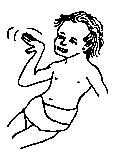 Ana
is 2 years old and still does not sit by herself. She has
strange uncontrolled movements. She does not play with toys or
respond much to her parents. Ana
is 2 years old and still does not sit by herself. She has
strange uncontrolled movements. She does not play with toys or
respond much to her parents.Ana seems
to have many problems.
We will need to check:
 | how well she sees and hears. |
 | how strong, weak, or stiff different parts
of her body are. |
 | in what ways her development is slow (what
she can do and not do). |
 | how much she understands. |
 | signs of brain damage, and how severe. |
 | her sense of balance and position. |
 | what positioning or support gives her
better control and function. |
It may take weeks or months of repeated
examining and testing to figure out all of Ana's difficulties,
and how to best help her to function better. It could be a
mistake to try to do all the needed examining at one time.
To record all the useful information on a
child like Ana, you will find RECORD SHEETS
1, 2, 3,
4, and 6
helpful. |
|
| 025 |
|
 | If the child seems nervous about a stranger touching or
examining her, have the parent do as much of it for
you as possible.
This will let the mother know that you respect and want to
include her. And she may learn more. |
|
 |
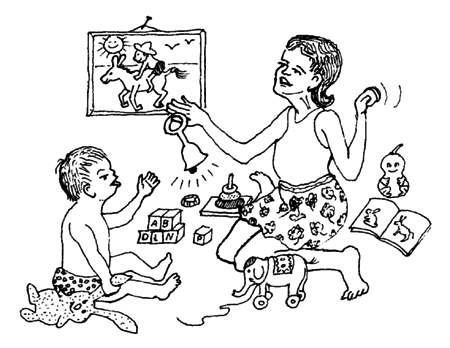 |
 | Make the waiting area and place where you do the examining
as pleasant and as much like home as you can.
Have lots of toys, from very simple to complex, where the
children can choose and play with them.
By watching if, how, for how long, with what, and with
whom a child plays, you can learn a lot about what a
child can and cannot do, his level of physical and mental
development, the types of problems he has, and the ways he has
(or has not yet) adapted to them. |
|
 |
Watching how a child plays
- by herself, with people, and with toys -
is an essential part of evaluating the child.
|
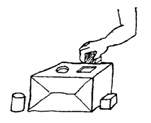 |
|
|
| 026
|
 | Try to make the examination interesting and fun
for the child.
Turn it into a game whenever possible. For example: |
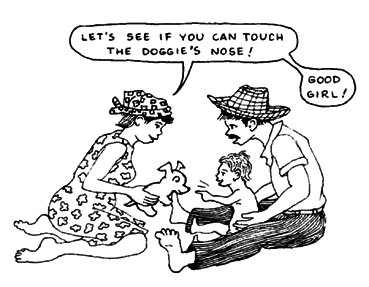
When you want to test a child's 'eye-to-hand coordination'
(for possible balance problems or brain damage) you might make
a game out of having the child touch the nose of a doll. Or
have her turn on a flashlight (torch) by pushing its button.
Also, when he begins to get restless, stop examining for a
while and play with him, or let him rest.

It is best to examine a child when he is well-rested,
well-fed, and in a 'good mood' - and when
you are, too. (We know this will not always be
possible.) |
|
|
| 027
|
TESTING RANGE OF MOTION OF JOINTS
AND STRENGTH OF MUSCLES
Children who have disabilities that affect how they move often
have some muscles that are weak or
'paralyzed'. As a result, they often do not move
parts of their bodies as much as is normal.
Loss of strength and active movement may in time lead to a
stiffening of joints or shortening of muscles (contractures,
see Chapter 8).
As a result, the affected part can no longer be moved
through its complete, normal range of motion.
| ACTIVE
MOVEMENT |
| Normally the shoulder
muscles can raise the arm until it is straight up.
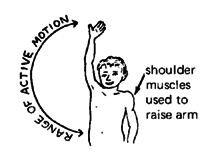
Lifting the arm like this with the arm's
own muscles is called ACTIVE
MOTION. |
When the shoulder muscles
are paralyzed, the child can no longer actively lift his
arm.

|
|
| PASSIVE
MOVEMENT |
| At first the paralyzed arm
can be lifted straight up with help. This is called
PASSIVE MOTION.
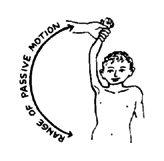
|
Unless the normal range of
motion is kept through daily exercises, the passive range
of motion will steadily become less and less.
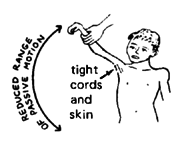
Now the arm cannot be raised straight
up, even with help. |
|
In the physical examination of a child with any weakness or
paralysis of muscles, or joint pain, or scarring from injuries or
burns, it is a good idea to test and record both RANGE OF
MOTION and MUSCLE STRENGTH of all Parts of the body that might
have contractures or be affected. There are 2 reasons for
this:
 | Knowing which parts of the body have contractures or are
weak, and how much, can help us to understand why a child moves
or limps as she does. This helps us to decide what
activities, exercises, braces, or other measures may be useful. |
 | Keeping accurate records of changes in muscle strength and
range of motion can help tell us if certain problems are getting
better or worse. Regular testing therefore helps us
evaluate how well exercises, braces, casts, or other measures
are working, and whether the child's condition is
improving, and how quickly. |
For testing range of motion and muscle strength, it helps to
first know what is normal. You can practice testing non-disabled,
active persons. They should be of the same ages
as the disabled children you will test. Age matters because babies
are usually weaker and have much more flexible joints than older
children. For example:

|
 |
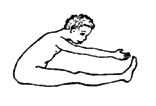 |
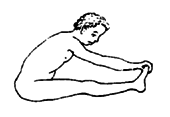 |
| A baby's back
and hips bend so much he can lie across his straight legs. |
A young child
bends less but can usually touch his toes with his legs
straight. |
Around 11 to 14
it is harder to touch toes. His legs grow faster and become
longer than his upper body. |
Later, upper
body growth catches up with legs. He can again touch toes
more easily. |
|
| 028
In different children (and sometimes in the same child) you
may need to check range of motion and strength in the hips,
knees, ankles, feet, toes, shoulders, elbows, wrists, hands,
fingers, back, shoulder blades, neck, and jaw. Some joints have
6 or more movements to test: bending, straightening, opening,
closing, twisting in, and twisting out. See, for example, the
different hip movements (range-of -motion exercises) on
Page 380 in
Chapter 42.
To test both 'range of motion' and 'strength',
first check 'range of motion'. Then you will know that when a
child cannot straighten a joint, it is not just because of
weakness.
Range-of-motion testing: Example:
Knee
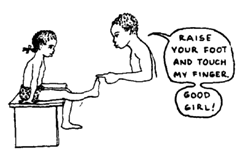 
1. Ask the child to straighten it as much as she can. |
With your hands,
support the joint on each side
as you straighten it.
2. If she cannot straighten it all the way, gently see
how far you can straighten it. without forcing. |
| 3. If at first the
joint will not straighten, keep trying with gentle
continuous pressure for 2 or 3 minutes. |

|
If it still does not
straighten, the range of motion is reduced. This is usually
because of a contracture (see
Chapter 8). |

|
If it gradually straightens,
spasticity (muscle spasms) may be
what makes it difficult (see Page
79). (if it stops before it straightens completely,
contractures may also be developing.) |
| 4. If a joint will
not straighten completely, try with the child in different
positions. |
 |
For example, a
knee often does not straighten as much with the hips bent as
with the hips straight. |
 |
For this reason,
each time you test range of motion to measure changes,
be sure the child is in the same position. |
|

Position affects how much certain joints straighten or
bend. This is true in any child, but especially in a child
with spasticity (see
Pages 101 to 103). |
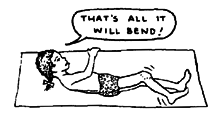 5.
In addition to checking how much a joint straightens,
check how much it bends. 5.
In addition to checking how much a joint straightens,
check how much it bends. |
If joints are kept straight and never bent,
they may stiffen or develop contractures that do not let
them bend. (This can happen with joint infection, arthritis,
and other conditions, or when a joint is kept in a cast for
a long time.) |
| 6. Also check for too
much range of motion. |

A child who walks on a weak leg often 'locks' her knee
backward to keep from falling. In time, the knee stretches
back more and more, like this.
|

The same thing can happen to the child with weak arms who
uses crutches (or crawls).
|
Usually the best positions for checking range of motion are
the same as those for doing range-of-motion and stretching
exercises. These are shown in
Chapter 42.
For methods of measuring and recording range of motion, see
Chapter 5.
029
Precautions when testing for contractures
Testing range of motion of the ankles, knees,
and hips is important for evaluating many
disabled children. We have already discussed knees. Here are a
few precautions when testing for contractures of ankles and
hips.
Ankle
 Note:
To check ankle range of motion in a child with
spasticity: Note:
To check ankle range of motion in a child with
spasticity: |
With his body and knee straight, it may
be hard to bend the ankle.

|
So first bend his neck, body, and knees
and then slowly bend up the ankle.
 |
Then slowly straighten his knee while
keeping the ankle bent.
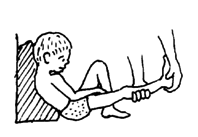
|
| Other precautions for
testing ankle range of motion are on
Page 383. |
|
Hip
| To check how far the hip joint
straightens, have the child hold his other knee to his
chest, like this, so that his lower back is flat against
the table. If his thigh will not lower to the table
without the back lifting, he has a bent-hip contracture.
(See Page 79.) |
 |

CAUTION:
The hips will often straighten more at an angle to the
body. So be sure to lower the leg in a straight line with
the body, or you can miss contractures that need to be
corrected before the child can walk. |
030
Muscle testing
Muscle strength can be anywhere between normal
and zero. Test it like this:
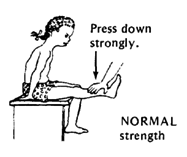
It the child can lift the weight of leg all the
way, press down on it, to cheek if she can hold up as
much weight as is normal for a girl her age. If she
can, her strength is NORMAL.
|

If she can hold some extra weight,
but not as much as is normal, she rates GOOD.
|
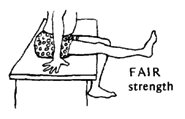
If she can just hold up the weight of her leg, but
no added weight, she rates FAIR. |
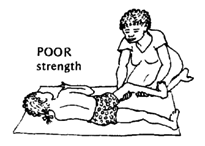
If she cannot hold up the weight of her leg, have
her lie on her side and try to straighten it. If she
can, she rates POOR. |
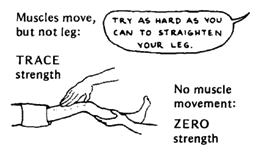
If she cannot straighten her knee at all, put your
hand over the muscles as she tries to straighten it.
If you can feel her muscles tighten, rate her TRACE. |
|
Test the strength of all muscles that might be affected.
Here are some of the muscle tests that are most
useful for figuring out the difficulties and needs
of different children.
|
Note:
These tests are simple and mostly test the strength of
groups of muscles.
Physical therapists know ways to test for
strength of individual muscles. |
031
|
To learn about which
muscles move body parts in different ways,
as you test muscle strength, feel which muscles and
cords tighten. |
Knee
| STRAIGHTEN
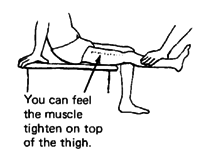 |
BEND
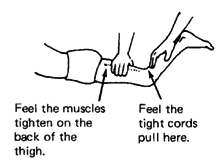 |
| EXAMPLES
OF REASONS FOR TESTING
 1.
POOR or NO strength for straightening knee may
mean an above-knee brace is needed. 1.
POOR or NO strength for straightening knee may
mean an above-knee brace is needed.
 2.
Stronger muscles in back of the thigh than in
front can lead to a bent-knee contracture 2.
Stronger muscles in back of the thigh than in
front can lead to a bent-knee contracture |
|
Hips
OPENING

|
CLOSING
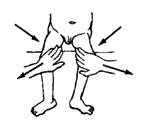
|
ROTATING HIP OUT
(and leg in)
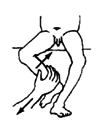
|
ROTATING HIP IN
(and leg out)
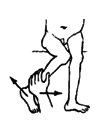
|
| SIDEWAYS LIFT

Note:
Weak hip muscles sometimes lead to
dislocation of the hip. Be sure to
check for this, too. (See
Page 155.)
Testing side-of-hip muscles is
important for evaluating why a child limps or
whether a hip-band may be needed on a long-leg
brace. |
| TEST FOR WEAK
SIDE-OF-HIP MUSCLES IN THE CHILD WHO CAN STAND
Have the child stand
on the weaker leg.
|
NORMAL
|
NOT
NORMAL
|
|
The child stands straight.
The hip tilts up on the lifted leg.

|
The hip tilts down on the
lifted side.
 |
Or the child shifts his whole
weight so it balances over the weak hip.
 This child dips to the side on each step of
the weak leg.
This child dips to the side on each step of
the weak leg.
(This is often seen with polio.) |
Note:
Dipping to one side when walking is caused
more by weak side-of-hip muscles than by a
shorter leg. But a shorter leg can make
dipping worse. |
|
.032
Stomach and Back
To find out how strong the stomach
muscles are,
see if the child can do 'sit ups' (or at least
raise his head and chest). |
To test the back muscles, see if he can bend
backward like this. |
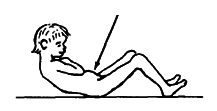
Sitting up with knees bent uses
(and tests) mainly the stomach muscles. Feel
stomach muscles tighten. |

Sitting up with knees straight uses
the hip-bending muscles and stomach muscles. |
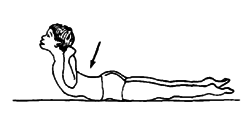
Feel the muscles tighten on either
side of the backbone. Notice if they look and feel
the same or if one side seems stronger. |
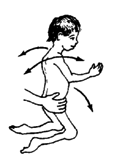
You can check a child's trunk control
and strength of stomach, back, and side
muscles like this. Have him hold his body
upright over his hips, then lean forward and back,
and side to side, and twist his body.
|

If a child's stomach and back muscles are weak, he
may need braces with a body Support- or a
wheelchair.
|
| IMPORTANT: Be
sure to check for curvature of the
spine- especially in children with
muscle imbalance or weakness of the
trunk. |
|
Shoulders, Arms, and Hands
| When a child's legs are severely
paralyzed but she has FAIR or better trunk
strength, she may be able to walk with crutches
if her shoulders, arms,
and hands are strong enough. |

Therefore, an important test is this.
Can she lift her butt off the seat like this? |
If she can, she has a good chance for walking with
crutches. |
If she cannot lift herself, check the strength in
her shoulders and arms:
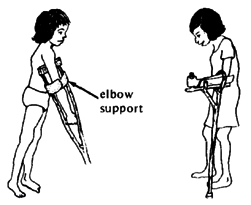
If the shoulder pushes down strongly but her
elbow-straightening muscles are weak, she may be
able to use a crutch with an elbow support.
|

Or, if her elbow range of motion is normal, she
may learn to 'lock' her elbow back like this.
However, this can lead to elbow problems.
|
033
You may want to make a chart something like this
and hang it in your examining area, as a reminder.
| In muscle testing, it is
especially important to note the difference
between FAIR and POOR. This is because FAIR is
often strong enough to be fairly useful (for
standing, walking, or lifting arm to eat).
POOR is usually too weak to be of much use.
|
| EVALUATING STRENGTH OR WEAKNESS OF MUSCLES
CAUTION: To avoid misleading
results, check range of motion BEFORE testing
muscle strength.
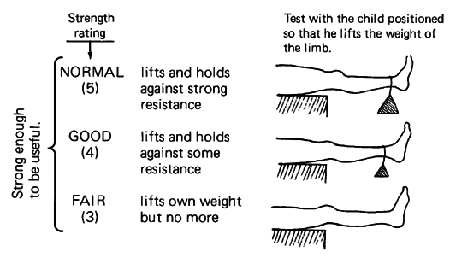
|
 |
|
Sometimes with exercise POOR muscles can be
strengthened to FAIR; this can greatly increase their
usefulness. It is much less common for a TRACE muscle
to increase to a useful strength (FAIR), no matter how
much it is exercised. (However, if muscle weakness is
due to lack of use, as in severe arthritis, rather
than to paralysis, a POOR muscle can sometimes be
strengthened with exercise to GOOD or even NORMAL.
Also, in very early stages of recovery from polio or
other causes of weakness, POOR or TRACE strength
sometimes returns to FAIR or better.)
034
Other things to check in a physical examination
Difference in leg length. When one
leg is weaker, it usually grows slower, and becomes
shorter than the other leg. An extra thick sole on the
sandal might help the child stand straighter, limp
less, and avoid curving of the spine. A short leg may
also be a sign of a dislocated hip. So it helps to
check for, and to measure, difference in leg length.
(For tests, see Page 155
and 156.)
If the child can stand,
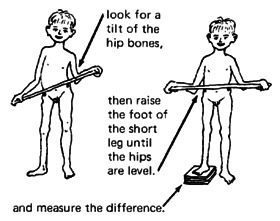
|
If she cannot stand,
have her lie as straight as she can. Feel and then
mark, on both sides of her body, the bony lumps

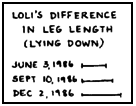
Then measure from here to here
with a tape measure or string. Measure each leg
and record the difference. If you used a string,
just draw lines on your record sheet showing the
actual difference in leg length. |
Curve of the spine
Especially when one leg is shorter or there are
signs of muscle imbalance in the stomach or back, be
sure to check for abnormal curve of the spine (back
bone). The 3 main types of spinal curve (which may
occur separately or in combination) are:
Sideways curve
(scoliosis) |
Hunch back, rounded back
(kyphosis) |
Swayback
(lordosis) |
|
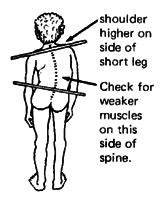 |
 |
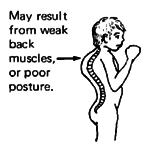 |
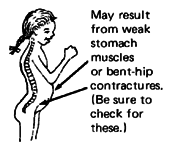 |
|
shoulder higher on side of short
leg. Check for weaker muscles on this side of
spine. |
Have the child bend over. Check
for a rib hump on outer side of curve. |
May result from weak back
muscles, or poor posture. |
May result from weak stomach
muscles or bent-hip contractures. (Be sure to
check for these.) |
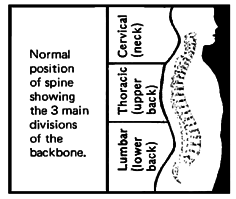
Some spinal curves will straighten when a child
changes her position, lies down, or bends over.
Other spinal curves will not straighten, and these
are usually more serious. For more information about
examining spinal curve and deformities of the back,
see Chapter 20. |
035
EXAMINING THE NERVOUS SYSTEM
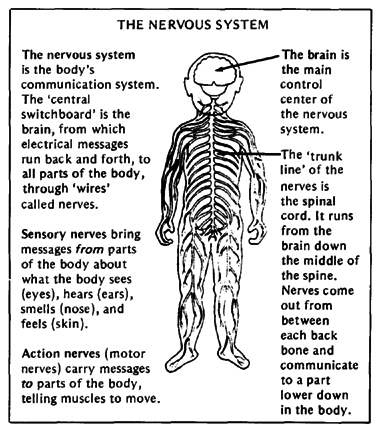
Sometimes physical disability results from problems
in the muscles, bones, or joints themselves. But often
it comes from a problem in, or damage to, the nervous
system.
Depending on what part of the nervous system is
affected, the disability will have different patterns.
For example, polio affects only
certain action nerves at points in
the spinal cord (or brain stem). It therefore affects
movement. It never affects sensory nerves,
so sight, hearing, and feeling stay normal. (See
Chapter 7.)
A spinal-cord injury, however, can
damage or cut both the sensory and action nerves, so
that both movement and feeling are lost. (See
Chapter 23.)
Unlike polio and spinal-cord injury, which come
from damage to nerves in the spine, cerebral
palsy comes from damage to the brain itself.
Because any part or parts of the brain may be damaged,
any or all parts of the body may be affected:
movement, sense of balance, seeing, hearing, speech,
and mental ability. (See
Chapter 9.)
Therefore, how completely you examine the workings
of the nervous system will depend partly on what
disability the child appears to have. If it is fairly
clear the disability comes from polio, little
examination of the nervous system is needed. But
sometimes polio and cerebral palsy can be confused. If
you have any suspicion that the disability might be
caused by brain damage, you will want to do a fairly
complete exam of nervous system function.
Damage to the brain or nervous system can cause
problems in any of these areas:
|
|
|
 | unusual or strange behaviors;
signs of self- damage (See
Page 364.) |
|
|
|
|
 | muscle tone (patterns of
unusual floppiness, tightness, spasms, or
movements). (See
Chapter 9.) |
|
|
|
|
|
 | balance, coordination, and
sense of position (See
Pages 90 and 105.) |
|
|
|
Methods for testing some of these things are
included on the next few pages and on the RECORD
SHEETS 2, 3, and 4. Other tests that you will need
less often, we include with specific disabilities.
Refer to the page numbers listed above. |
|
036 |
EVALUATION OF A CHILD WHOSE DEVELOPMENT IS SLOW
For the child who cannot do as much as other
children do at the same age, a special developmental
evaluation may be helpful. Additional information
about the child's mother during pregnancy, or any
difficulties during or after birth may explain
possible causes. Measurement of the distance around
the head may show possible causes of problems or
other important factors. Repeated head-size
measurements (once a month at first) may tell us
even more.

For example, a child who has had meningitis
(brain infection) at age 1, and whose head almost
stops growing from that age on, will probably remain
quite retarded. We should not expect a lot. However,
if the child's head continues to grow normally, the
child may have better possibilities for learning and
doing more (although we cannot be sure).

A child who is born with a 'sack on the back'
(spina bifida, see Page 167)
may have a head that is bigger than average. If the
head continues to grow rapidly, this is a danger
sign (see Page 41 and
169). Unless the child
has surgery, she may become severely retarded or
die. If, however, the monthly measurements show that
the head has stopped growing too fast, the problem
may have corrected itself. She may not need surgery.
RECORD SHEET 4, on page 41,
covers additional questions relating to child
development, and includes a chart for recording and
evaluating head size.
To help the child who is developmentally
delayed, you will first want to evaluate her level
of physical and mental development.
Chapter 34,
Pages 287 to 300,
explains ways to do this.
You can use the Child Development Chart on
Pages 292 and
293 to find a child's
developmental level, to plan her step-by-step
activities, and to evaluate and record her progress.
We have marked this 2-page chart, RECORD SHEET 6.
RECORD SHEETS
On the next 5 pages are the sample RECORD SHEETS
that we discussed on Page 22. You
are welcome to copy and use them. However, they are
not perfect. They were developed for use by the
village rehabilitation team in Mexico, and we are
still trying to improve them. Before you make
copies, we suggest that you adapt them to meet the
needs of your area.
| Be sure you have copies made of
the RECORD SHEETS you will need
before you need to use them.
|
In addition to the 4 RECORD SHEETS here, you may
also want copies of RECORD SHEET 5 "Evaluation of
Progress," Page 50, and
RECORD SHEET 6, "Child Development Chart,"
Pages 292 and
293.
| Note on RECORD SHEET 1 (CHILD
HISTORY):
The box at the top of RECORD SHEET 1 is to
be filled out after you examine the child. It
gives brief, essential information. This will
make it easier to find out which disabilities
you have seen most often, and to check on what
you still need to do for different children.
The last few questions on Page 2 of RECORD
SHEET 1 are for a study PROJIMO is doing on
medical causes of disability. Adapt them to
study special concerns in your area. |
|
|
|